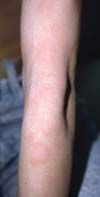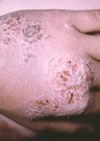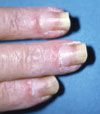Atopic Dermatitis Provoked by Heat and Humidity and Traumatic Onychodystrophy
Pruritic eruptions on both arms of a 12-year-old who has played outdoors all summer; a rash on the hand of a teenage baseball player . . . might sports be responsible for these lesions?

Case 1:
For several weeks, a 12-year-old boy has had highly pruritic eruptions on both arms. He denies any obvious exposure history, but he has played outdoors extensively this summer and says that the rash is itchier when he perspires. His family owns a dog and his siblings have seasonal allergies and asthma.
Which of the conditions in the differential is the likely diagnosis?
A. Contact dermatitis.
B. Psoriasis.
C. Atopic dermatitis.
D. Tinea corporis.
E. Granuloma annulare.
(Answer on next page.)

Case 1: This patient had a summertime flare of atopic dermatitis, C, provoked by the heat and humidity. Excessive bathing had exacerbated the condition. Treatment consisted of as-needed application of a mid- potency topical corticosteroid.
Contact dermatitis usually features some linear lesions and would be expected to abate after a few weeks. Psoriasis has more scale and involves the area around the elbows. A tinea corporis eruption is rarely this extensive, and the lesions are scalier than this patient's rash. Granuloma is not pruritic.

Case 2:
A 24-year-old woman has had a long-standing lesion on a fingernail. Examination reveals a roughened nail surface, absence of the cuticle adhering to the nail plate, and mild erythema and edema of the proximal nail fold. Trials of topical antifungal agents have been unsuccessful. She is otherwise healthy; her only medication is an oral contraceptive. No other nails are involved and she has no rashes.
What does this look like to you?
A. Psoriasis.
B. Lichen planus.
C. Candidiasis.
D. Dermatophyte infection.
E. Traumatic onychodystrophy.
(Answer on next page.)

Case 2: This patient had traumatic onychodystrophy, E. Further clinical examination revealed evidence of small petechiae, which suggested a history of trauma. On further questioning, the patient reported a long-standing habit of picking at her cuticle. This eventually caused her nail deformity. Treatment consisted of occlusion to prevent further trauma and consultation with a psychiatrist for her obsessive-compulsive disorder.
Psoriasis usually presents with nail pitting and/or distal onycholysis. In patients with lichen planus, more than 1 nail is usually involved and there is no cuticle trauma. Candidiasis typically causes erythema and edema of the nail fold. Dermatophyte infections cause whitening of the nail plate and subungual debris, which are not seen here.

Case 3:
A rash on the dorsum of the left hand developed in a right-handed 14-year-old boy several weeks after he started playing baseball regularly. He has a history of seasonal allergies, which are controlled with an oral antihistamine. He has no other recent exposure history.
What is the likely diagnosis?
A. Neurodermatitis.
B. Psoriasis.
C. Contact dermatitis.
D. Atopic dermatitis.
E. Dermatophyte infection.
(Answer on next page.)

Case 3: This patient had an exacerbation of atopic dermatitis, D, from the new baseball glove. Patch testing ruled out contact dermatitis from one of the components of the glove. The combination of occlusion and perspiration was thought to have triggered the flare. He was advised to use a low-potency corticosteroid cream for the duration of the baseball season.
Neurodermatitis might be considered if the patient was unduly anxious about playing baseball. Psoriasis is usually bilateral and would not be confined to the dorsum of a hand. A dermatophyte infection would not be this extensive, even with the occlusion of the glove. Such an infection can be definitively ruled out with a potassium hydroxide evaluation.


Case 4:
After being hospitalized for a stroke, a 75-year-old woman noticed scaly, erythematous patcheson her palms and changes in her nails. The rash is asymptomatic and there is no exposure history. She takes anticoagulants and antihypertensives.
What type of rash is this?
A. Neurodermatitis.
B. Psoriasis.
C. Asteatotic eczema.
D. Contact dermatitis.
E. Atopic dermatitis.
(Answer on next page.)


Case 4: The stress of the stroke resulted in an outbreak of mild psoriasis, B, in this patient. The diagnosis is supported by the characteristic nail pitting, early distal onycholysis, and hints of subungual debris. The eruption was treated with a mid- potency topical corticosteroid.
None of the other conditions in the differential produce discrete lesions or nail changes.